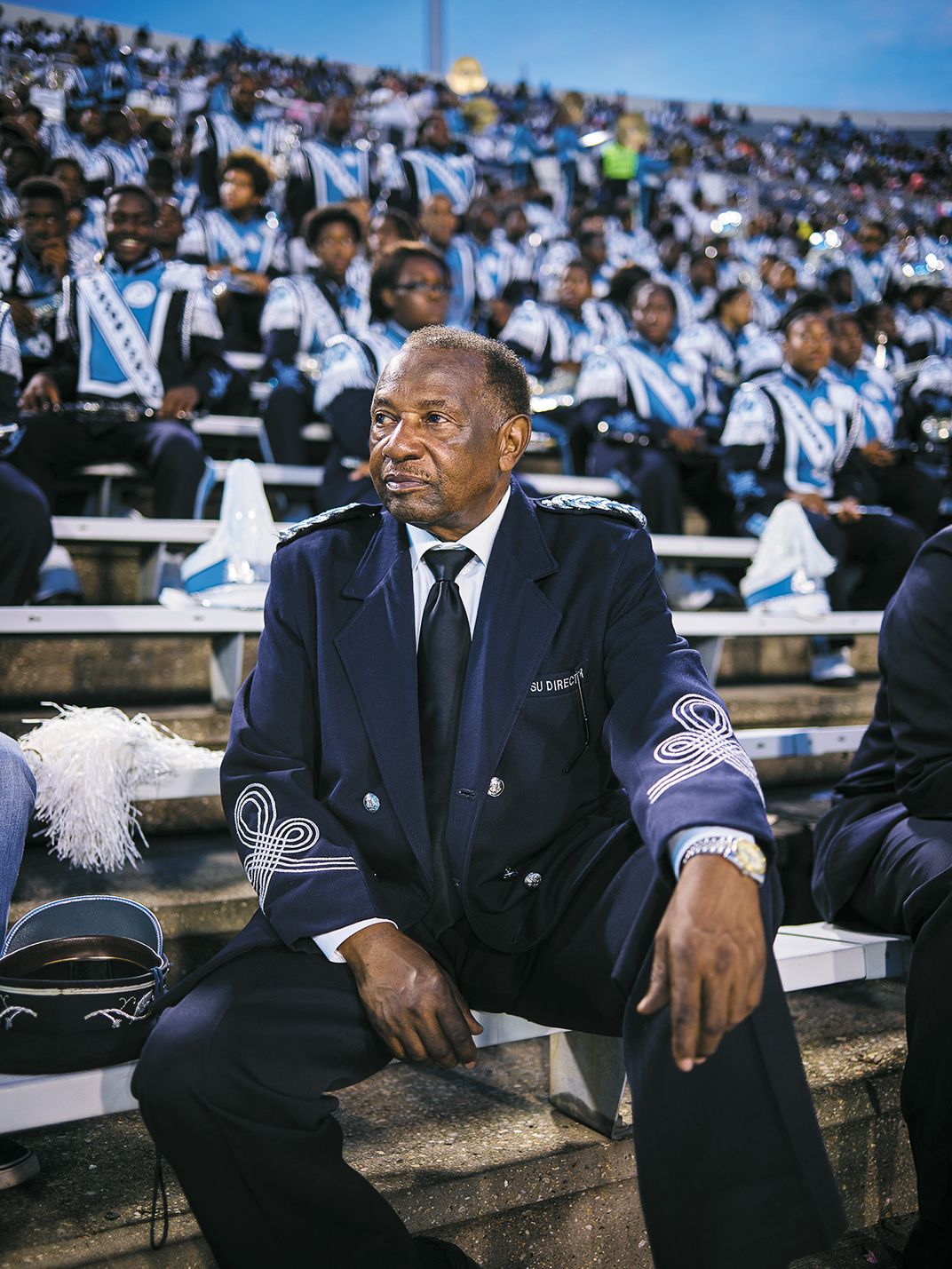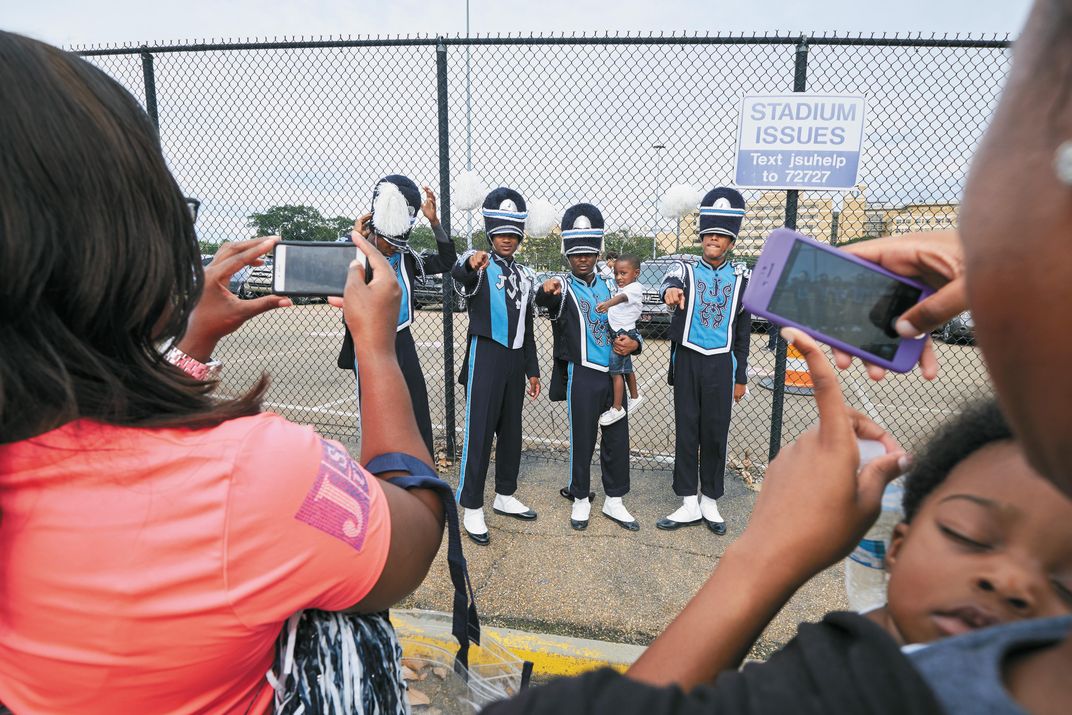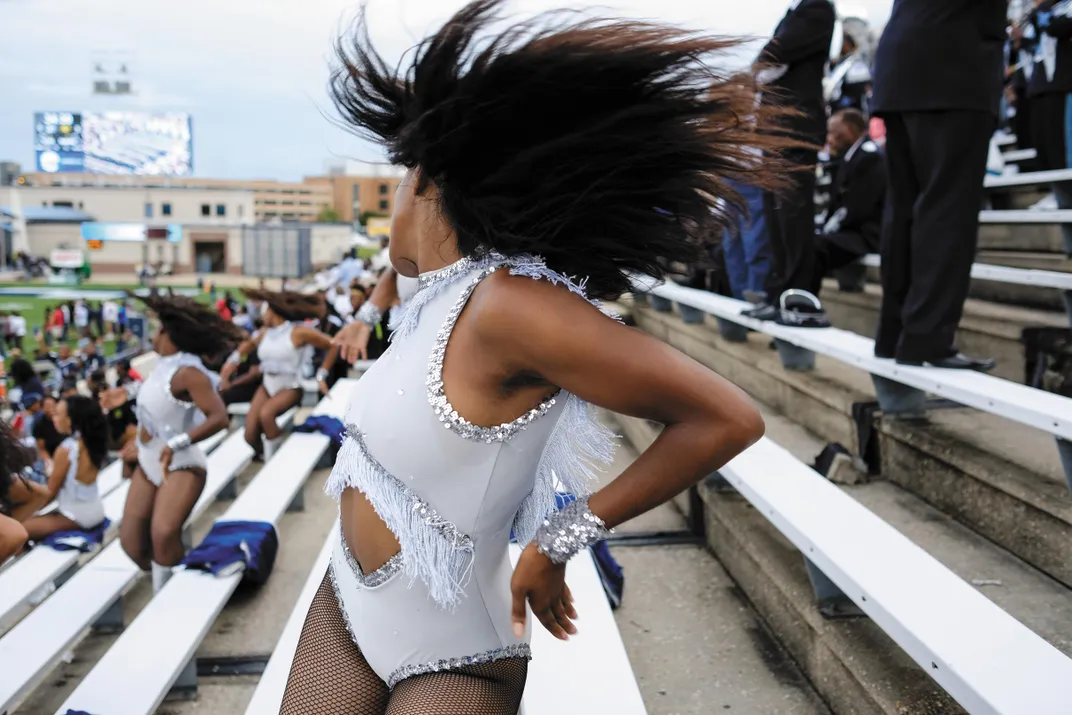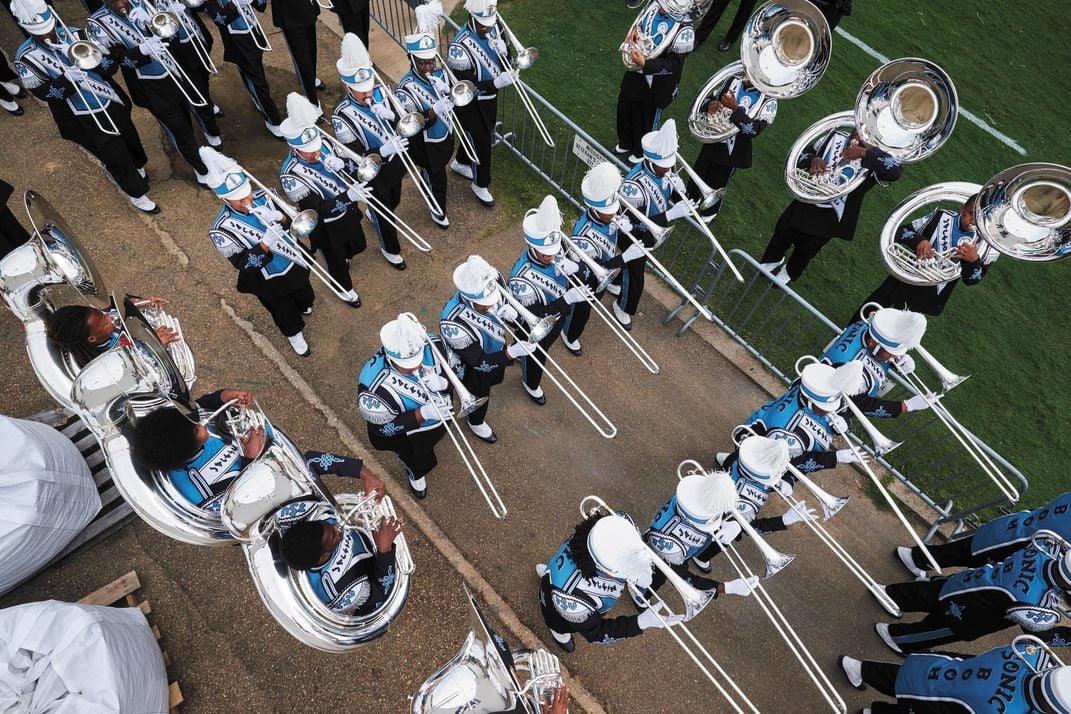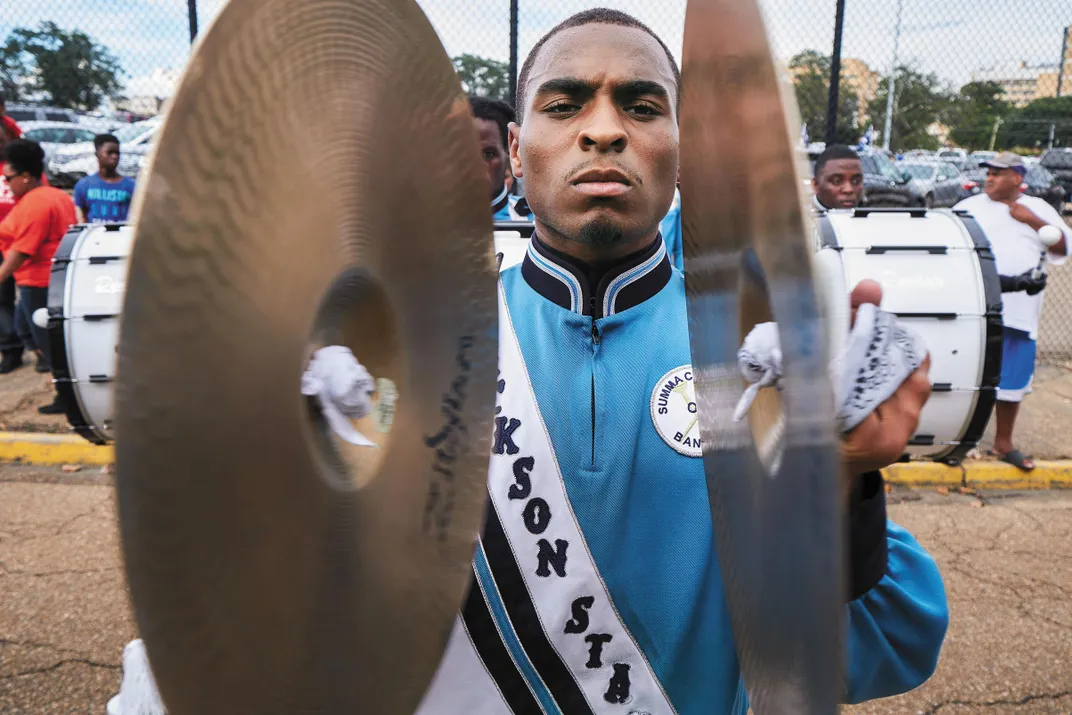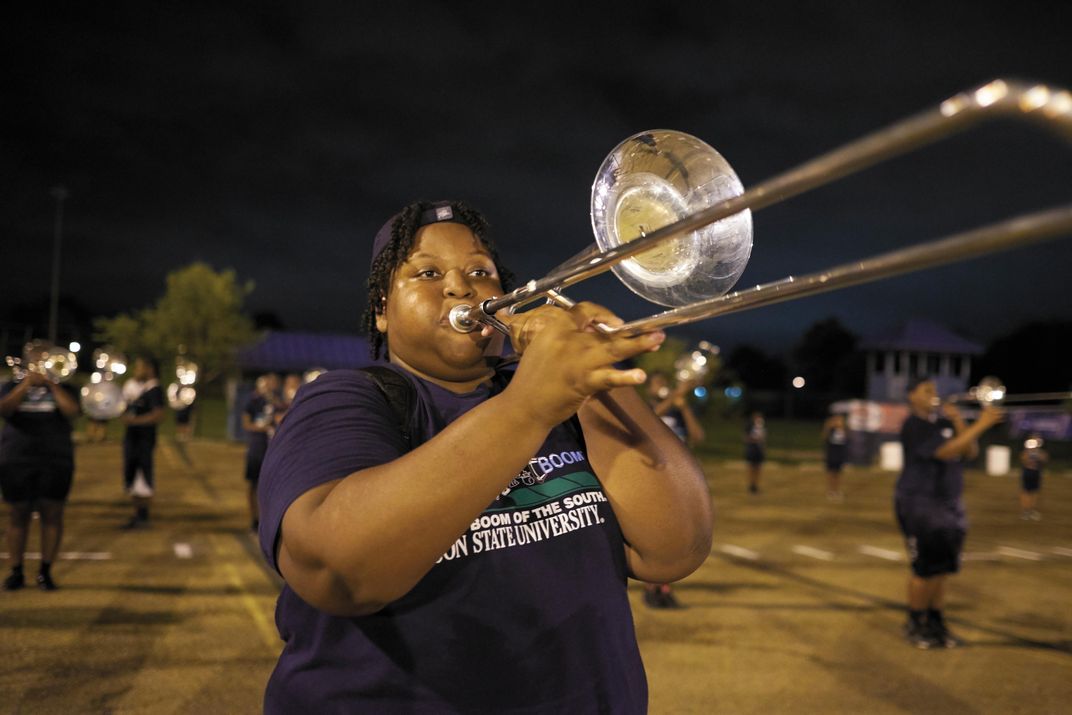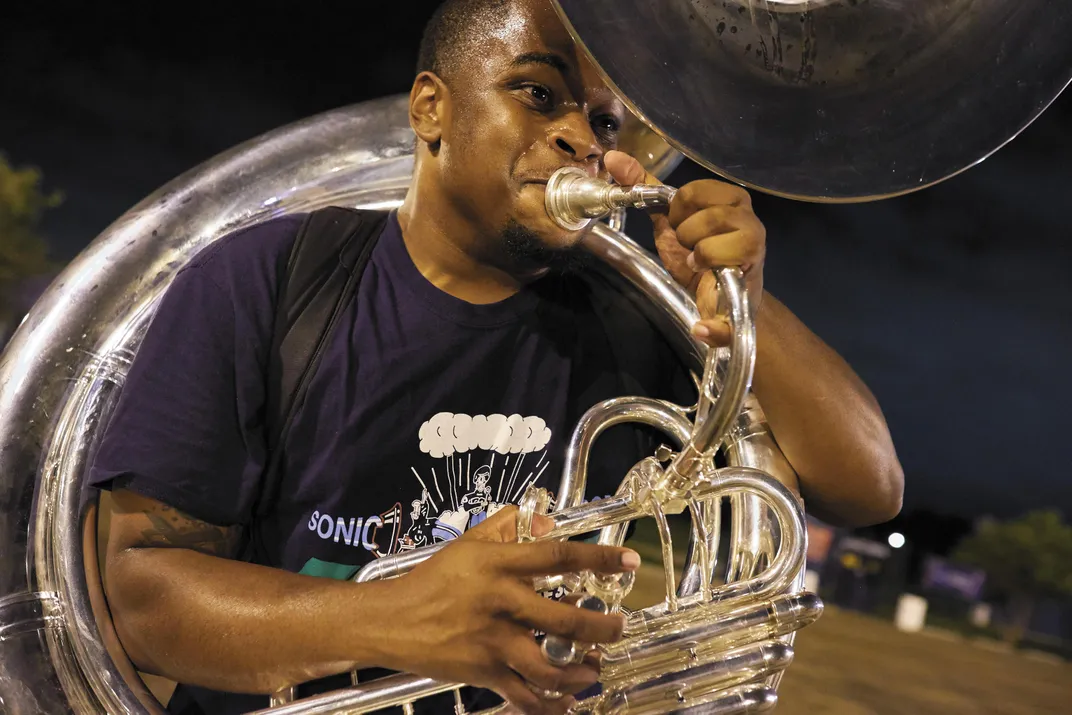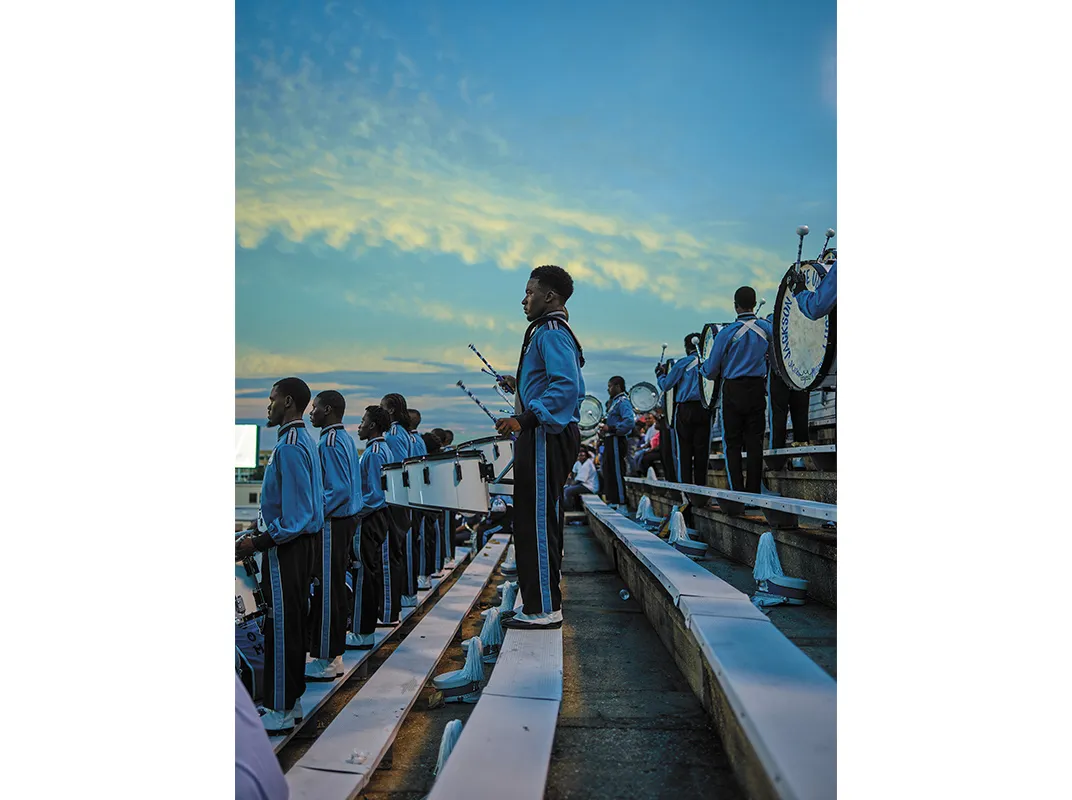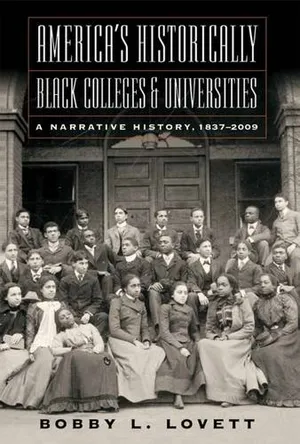March to the Joyous, Raucous Beat of the Sonic Boom of the South
College football seasons come and go, but the joyous thunder of Jackson State’s iconic marching band rolls on
It takes two charter planes to move the Sonic Boom of the South from its home in Jackson, Mississippi, to the first event of the season, in Las Vegas, Nevada. The 230 musicians are traveling with four band directors, support and medical staff, a security detail, a social media and video unit, cheerleaders and a team of swivel-hipped female dancers called the Prancing J-Settes.
The Sonic Boom of the South is the marching band of Jackson State University, and a leading exponent of the high-stepping, high-energy, razzle-dazzle style that has developed in historically black colleges and universities (HBCUs) in the Deep South. Known as “show style,” it combines the military marching band tradition with funky syncopated rhythms and elements of jazz, R&B, pop and hip-hop. The bands play with tremendous power and incorporate tightly choreographed dance routines into elaborate field drills. This unique American art form has honed and perfected itself over many decades and is now breaking through into wider cultural prominence.
Michelle Obama, in her commencement speech at Jackson State in April 2016, declared the Sonic Boom of the South one of the best bands in the country, and told university officials how much she enjoyed watching the band’s performances on YouTube. The Boom, as it’s known for short, played at the 2016 inauguration of Mississippi Gov. Phil Bryant, and just headlined the annual Jackson Christmas Parade, a holiday tradition drawing thousands of spectators. “We don’t have the very best musicians, or the most precise drill formations,” says O’Neill Sanford, the director of bands at Jackson State. “But no one else can bring the same energy and showmanship, and electrify a crowd of 110,000 people like we can,” he says. “That’s what everyone wants to see.”
**********
The University of Nevada, Las Vegas (UNLV) has invited Jackson State to play the opening football game of the season, but the invitation, co-sponsored by the Las Vegas Convention and Visitors Authority, had little to do with football. The contract specifies that the Sonic Boom of the South, in its full entirety, must accompany the football team and perform at halftime. Other colleges and universities around the country have started doing the same thing. They’re inviting historically black college football teams in order to see their marching bands.
For many of the Boom’s members, this is the first time they’ve flown on a plane, or traveled out West. The excitement, however, is offset by deep fatigue, especially among the freshmen. They have just come through a brutal two-week initiation known as Freshman Band Camp. It takes place every year in August, when Mississippi heat and humidity are most oppressive.
“Their parents drop them off, their mamas weep and hug them goodbye, they check into the dorms, and the next morning, we start before dawn,” says Sanford, a legendary figure in the college marching band world, charming, unflappable, highly astute and now approaching retirement. “Most kids today are so weak,” he adds, noting that the band requires strength. “So we tear them down to build them up.”
Kevin Levine, a Jackson city police officer and former Sonic Boom member, is in charge of the physical training. He leads the freshmen through a long, punishing routine of military calisthenics every morning, and sends them to a designated fall-out area if they need to collapse or vomit. “Let it go, son,” he calls out to the nauseated. “Release your impurities.”
Band camp days last for 18 and sometimes 20 hours to build stamina, and because there’s so much to learn. Most freshmen come out of high school bands that march with a “corps step”—the feet stay low to the ground, landing heel-first and rolling toward the toe. The Sonic Boom marches with the traditional military high step, lifting up the knees to a 90-degree angle and pointing the toes downward. It’s more difficult to keep your lips tightly positioned on the mouthpiece of a horn while marching like this. To make it even more challenging, the Boom also marches with a sideways sway in the upper body, making all the helmet plumes move in unison, and sometimes the musicians have to play while executing vigorous dance moves.
There’s also a mother lode of music to learn. After football games, in the so-called fifth quarter, and at special events like the annual Honda Battle of the Bands—which the Sonic Boom won by fan poll in 2016, after rocking a crowd of 63,000—marching bands taunt and challenge each other. Using their instruments like weapons of war, they try to dominate their opponents in terms of volume, energy, musicianship and song selection. Sometimes these battles go on for 90 minutes or more. The Sonic Boom requires its musicians to master and memorize pieces from patriotic marches to the latest club hits. Everyone in the marching band program is also required to learn classical pieces and many Boom members also play in the school’s symphonic band.
Then there are the field drills for the halftime performances, endlessly rehearsed on a big parking lot near the campus sports fields, under the direction of the tireless Roderick Little, a former Sonic Boom drum major who is now associate director of bands. By taking precise 221⁄2-inch steps, and following memorized instructions, the band members use their bodies to create letters, numbers, chevrons, revolving pinwheels and other formations of human geometry on the pitch.
At the end of band camp this season, surviving freshmen—68 of 94 made the cut—were merged with the upperclassmen, and the 2016 Sonic Boom of the South played together for the first time in front of a huge, cheering crowd on campus. Just a few days later, they were shuttled out to the airport and loaded onto the charter planes.
“It takes a lot of blood, sweat and tears, but it’s an incredible feeling,” says James Gray III, a trumpet player from Tuscaloosa, Alabama. “Most of us have been watching Boom videos on YouTube since we were kids and dreaming about marching in the band one day. To know that I made it happen is something I’ll carry with me for the rest of my life.”
The 100-plus members of the UNLV marching band are getting into their uniforms behind the stadium, looking very casual and relaxed, when the Sonic Boom’s mighty drums start up across the parking lot. The vibrations from the big, heavy bass drums, nine in all, are so powerful that they set off a car alarm 70 yards away. The snares sound like rattling machine-gun fire. “Holy s---,” says a big UNLV tuba player, scrambling to put on the rest of his uniform.
Then the long, gleaming procession comes into view, all polished brass, swaying helmet plumes, and flashy blue-and-white uniforms. The percussionists have dyed their tongues blue with Kool-Aid and candy (an old tradition) and many of them have a fierce, warlike expression on their faces as they march past the stunned, half-dressed UNLV band members.
Leading the Boom are four lean, handsome, high-strutting drum majors in massive, plumed shako hats, coursing with so much energy that it seems their bodies can barely contain it. Their names are Joe “Rogue Dynasty” Williams III, Abraham “The Prototype” Duffie, Tyler “Mr. Blue Phi” Battle and Giann “Mr. 704” Soto. On the Jackson State campus, their social status eclipses that of any athlete. Celebrated for their dancing skills and showmanship, the drum majors also have a vital leadership role in the band, acting as field commanders for the band directors.
“We’re a paramilitary organization with tight discipline and a chain of command,” says Williams. “We can also make a whole stadium get up and feel good.”
Behind the drum majors, swinging their hips and smiling, are ten young women known as the Prancing J-Settes. They’re wearing silver boots, blue-and-silver capes, and showgirl leotards with sequins and tassels. Nicknamed “The Thrill of a Million Eyes,” the J-Settes were recently voted the best female danceline of all the historically black college marching bands.
These dancelines developed out of the drum majorette tradition. They gave up batons to concentrate on dance. The J-Settes have a wide repertoire of moves, ranging from elegant interpretations of symphonic music to high-speed booty-shaking and go-go routines. They claim to have pioneered a raunchy pelvic thrusting move known as “bucking” that has since become widespread in dancelines.
In the Las Vegas crowd of 18,575 are a few hundred alumni from historically black colleges. They wear the names of alma maters on caps and T-shirts—Jackson State, Alcorn State, Grambling State, Mississippi Valley State, Tennessee State and a few others. Jermaine Rimmey went to Southern University in Baton Rouge and now lives in Las Vegas. “Jackson State are our biggest rivals, but I’m cheering for them today,” he says. “I can cook my Louisiana food out here, but I get homesick for bands and band culture.”
Asked to describe that culture, he says, “I hate to bring race into it, but at a predominantly white game, people leave their seats at halftime and get a hot dog or whatever. At an HBCU game, nobody leaves at halftime, because that’s when the bands come on. We support our football teams, but the rivalry, the excitement, the arguing and talking smack, it’s all about the bands.”
On YouTube, and at websites like BandHead.org and HBCUdigital.com, Rimmey follows all the marching bands in the Southwestern Athletic Conference, or SWAC, which extends from Alabama to East Texas and is famous for its show-style bands. Florida A&M (FAMU), outside the SWAC, is the biggest and most famous band of all, says Rimmey, but it still hasn’t recovered from the 2011 hazing death of drum major Robert Champion, and the suspension that followed. (As a pledge, Champion was required to run down the center of a bus while being punched, kicked and assaulted by more senior band members, and he died from the blows. Following that incident, HBCUs have cracked down on the hazing traditions in their marching bands.)
As Rimmey and his friends wait for halftime, they watch and groan as the Jackson State Tigers get demolished on the football field by the UNLV Rebels. At halftime, the score is 42-10. The stadium announcer warns the fans against leaving their seats, because of the special show coming up, “with one of the best marching bands in the land.”
The UNLV band comes out first, marching corps-style. They play a cheesy old polka known as “The Chicken Song,” and do a little leg kick move when they go into “YMCA” by the Village People. The drum majorettes catch their batons, the band doesn’t make any mistakes, but by HBCU standards, it looks almost incredibly lame and lackluster.
The Sonic Boom, with double the numbers, lines up in crisp ranks at one end of the field. The drum majors stand to attention around the 20-yard line, then whistle, chant and swing their long maces over their heads. Suddenly the entire band is racing with a high-speed shuffle step, dizzying the eye by going in two directions at once and changing speeds, and then forming eight long straight lines that re-form as diagonals. This is the famous Tiger Run-On, and the Vegas crowd goes wild for it.
During the long days of band practice, Roderick Little will sometimes tell the musicians to “tear open the sky with your sound.” This phrase well describes the huge, piercing, thrilling sound of all the horns and woodwinds as they let rip for the first time, blowing an almighty overture before going into Gwen Stefani’s “Sweet Escape,” while spelling out the letters UNLV and JSU with their bodies. Then the Sonic Boom floats these letters down the field, with no wavering or wobbling, while the drum majors leap and dance. They defy gravity with their back bends, and when they do splits, they bounce right out of them without missing a beat, like James Brown.
Now the J-Settes come out, having changed into gold lamé and tiger-print bikini-style outfits, prancing and high-kicking and tossing their manes of woven hair, their display proud and eye-catching. For a finale, the Sonic Boom performs its theme, or “spirit song,” “Get Ready,” by the Temptations. The band members spell out the letters LAS VEGAS, while the drum majors do the “Mean Lean,” marching with their knees flying up to their chests, while tilting their bodies sideways, and the “Funky,” which “Rogue Dynasty” Williams describes as a “ground-shaking hip gyration.” As the Boom marches out, the entire stadium rises to its feet, clapping, cheering, yelling, full of joy and appreciation.
“I’m real proud of them,” says Little, marching out with them in his band director’s suit and tie. “A feather in our cap,” says Sanford.
**********
The origins of African-American marching bands can be traced back to the black regimental bands in the Union Army, and the brass bands that emerged in New Orleans after the Civil War. In the same postwar era, the first colleges and universities for African-Americans were created. From the earliest days of their existence, according to marching band historian William D. Lewis, black colleges and universities took great pride in their music and band programs, and played music in both the European and the vernacular American tradition.
The high-stepping pageantry of the modern show-style band seems to have evolved during practice sessions at Florida A&M University in 1946, under the band director William Foster. “We were just doing steps and high-knee lifts, and people thought that was the greatest thing on earth,” he once recalled. “I had a physical education teacher to help with the choreography, putting the steps to music...very shortly afterwards, other bands started doing it.”
At Jackson State, the seminal figure was the dapper William W. Davis, whose portrait hangs in two places today in the trophy-stuffed music building. An ex-Army bandsman, he went on to arrange music and play trumpet in Cab Calloway’s orchestra, before becoming JSU’s first band director, in 1948. Davis introduced jazz rhythms and Calloway-style showmanship to the 20-odd students in the marching band. By 1963, the band had swelled to 88 members, and they were playing Count Basie and Duke Ellington arrangements at football games.
In 1971, Davis was succeeded by Harold Haughton, who adopted the name Sonic Boom of the South, created the Tiger Run-On, and boosted the musicians to 160. “Marching bands were a big thing at HBCUs in the 1970s, but the real competitiveness was about football back then,” says Sanford. White universities in the South were very reluctant to recruit black athletes, so historically black schools were fielding football greats like Walter Payton, who played for Jackson State. Jerry Rice, the Hall of Fame wide receiver, played his college ball at a small HBCU called Mississippi Valley State University, from 1981 to 1984.
“During the 1980s, white colleges started letting black athletes in, and after that, they always took our best players away from us,” says Sanford. “People got fed up with it, the standard of football went down, and the emphasis switched to bands. No one wanted to take our musicians.”
In recent years, some predominantly white college marching bands have borrowed heavily from historically black show-style bands, most notably Ohio State, whose 2013 tribute to Michael Jackson, featuring a moonwalking field drill, went viral on YouTube. Some critics saw it as cultural appropriation, and O’Neill Sanford certainly wasn’t impressed. “People go on about Ohio State, but we were doing all that stuff 40 years ago,” he says. “The only difference is that no one was recording it and posting it on the internet.”
Early in his career, Sanford broke racial barriers by becoming the first African-American band director at the University of Minnesota in 1976. When he arrived, the marching band was all white and playing polkas, marches and show tunes. By the time he left, in 1985, the band contained some students of color, and it was playing Earth, Wind & Fire and a few other R&B songs. Then he went to the University of Pittsburgh, where he endured and overcame a harassment campaign that included a burning cross on his lawn.
Marching bands have taken him on extended jaunts to England, Spain and Sweden. He holds an honorary doctorate from the National Conservatory of Music in Mexico City, and Hollywood is now interested in his life story. “It’s been an incredible journey for a black kid from a tiny town in rural Louisiana,” he reflects. “Now I’m back where I started, directing an HBCU band in the South and bringing back everything I’ve learned.”
He travels all over the country, and recently to the Virgin Islands, to scout out the best high school band musicians and lure them to JSU with scholarship money. Rival band directors are doing the same thing, although increasingly they do their talent-scouting on social media to save time and money.
Last season, the Sonic Boom had 350 musicians and played at enormous volume. This season, owing to state budget cuts and other financial hardships at JSU, there’s less money available for band scholarships, and the Boom has shrunk to around 210 members, with variations week to week. Lowell Hollinger, the associate director, doesn’t see this shrinking as a problem, “The more bodies you have, the harder it is to make them sound like one. It can get ragged so easily. We’re noticing something special this year, something ethereal that’s hard to put your finger on. We’re excited for great things.”
The Saturday after Las Vegas, when the Sonic Boom marched out against Tennessee State in Memphis, all the horn and woodwind players were holding brand-new instruments, funded by the cash-strapped university at a cost of more than $460,000. The old instruments were wearing out, and the new ones, all made by the same company, sounded more harmonious with each other. “It increases our competitive edge,” says Sanford. “But nothing happens cheaply with a band this size.”
The uniforms cost $250,000. Six tour buses are required for transportation. Every time the band eats, it’s $6,000 or more. For JSU, it’s punishingly expensive to maintain the Sonic Boom at its current level of excellence, but as Sanford puts it, “The band is the best recruiting tool they have.” If the Boom were to shrink further and slip down a few notches, the whole university would suffer, not just in terms of pride, but future enrollment and alumni support. More than a few HBCUs have already suffered through this cruel, downward band-related spiral.
Jarrett Carter Sr., founding editor of HBCUdigest.com, wants to know why historically black schools haven’t managed to monetize their marching bands, at a time when they’ve never been more popular. The main problem, as he identifies it, is that social media is the primary venue for this popularity. YouTube, Facebook, Snapchat and other companies are displaying band videos without paying for them and hogging the advertising income they generate.
Carter notes that HBCU bands have played Super Bowl halftimes and appeared in pop videos and reality shows. They were celebrated in the 2002 movie Drumline, which overcame a clunky story line to earn $56 million at the U.S. box office. Florida A&M was one of some 90 groups that marched in President Obama’s 2009 inaugural parade. Despite all this exposure, he writes, “many of these schools face dire economic straits.” He calls for HBCUs to get sponsors’ logos on band uniforms, sell paraphernalia, professionalize video production and start treating their bands as a valuable product with “hundreds of thousands of brand-loyal consumers.” Sanford strongly agrees. “Marching bands are a great public relations tool, but they’re also capable of generating serious financial resources. That’s what we need to start thinking about.”
**********
In college sports, the most intense rivalry in the South is between the University of Alabama and Auburn University football teams. Right behind that is the rivalry between the Jackson State and Southern University marching bands. Grudgingly, if pushed, the Sonic Boom will admit that the Southern band, nicknamed the Human Jukebox, is close to being its equal. Every time the two bands go up against each other, the competition is fraught with tension, drama and excitement. It’s known as the Boombox.
Now the two bands are scheduled to battle each other at a new event in New Orleans called Crankfest. (“Crankin’” is a slang term for an impressively loud band.) There will be no football teams present, and no other bands. “This Event Promises to Be the Most Spectacular, High-Energy, Action-Packed Exhibition of Power House Marching Band Programs in the Nation!!” according to a Crankfest web page, “in the Band Head Capital of the Universe.” Tickets cost from $25 to $60.
Normally, the Sonic Boom rehearses every day from 5:30 p.m. to 10 p.m. This week, rehearsals have been ending after midnight, as the band attempts to master 15 new songs. The Southern band is known as the Human Jukebox because of the huge selection of songs it can play. No one is sure how long Sunday’s battle will last, but the Boom definitely doesn’t want to run out of ammunition.
“New Orleans is just a short hop from Baton Rouge,” says Hollinger. “We’re going into a hornet’s nest.” When the Sonic Boom’s buses reach the Tad Gormley Stadium, in a city park in the heart of New Orleans, there are thousands of people outside, slowly funneling in through the turnstiles, and sure enough, many of them are wearing the gold shirts and caps of Southern University.
**********
Inside the stadium, Kool DJ Supamike is spinning tunes for Southern, and DJ Poppa is representing JSU. Before the battle begins, they warm up the crowd with bass-heavy dance beats. The rules of engagement have been set in advance. The bands will wear athletic clothes, not marching uniforms. They will not interrupt each other, or try to drown each other out. The Sonic Boom will march in first.
In dark blue warm-up suits and matching caps, with blue-tongued percussionists and pink stickers—promoting the cause of breast cancer awareness—on their left cheekbones, the Boom enters the stadium with its drumline pounding at maximum volume, then launches into the irresistible funk of “Get Ready,” with the drum majors dancing furiously. “Give it up, y’all!” yells the announcer. “We find out tonight who’s got the hottest band in the land.” The Boom files up into an empty stand and arranges itself on the bleachers, as the Human Jukebox, “often imitated, never duplicated,” appears at the other end of the stadium.
The Southern drumline doesn’t pack quite the same force, and the rest of the band stays silent as it marches through the stadium and up into the stand next to the Sonic Boom. The Prancing J-Settes, dressed in plain athletic leggings and tops with their midriffs bare, do not look happy. Their opponents, the Dancing Dolls, are wearing cutaway gold lamé leotards with white gloves.
Now the conductors climb their stepladders, and the battle begins. Roderick Little raises his baton and leads the Boom through a rousing old march called “Them Basses,” written in 1924. The Boom performs it magnificently, but the partisan crowd jeers and boos. Then it’s Southern’s turn, and the crowd roars because the Human Jukebox is definitely louder, with a massive high brassy sound that’s almost earsplitting. The Southern drum majors make throat-cutting gestures toward the Sonic Boom, and the Dancing Dolls catch the light on their skimpy gold costumes as they shake and gyrate.
Then it’s back to the Boom. Scholarship cuts have eaten into their volume, which is a problem, but they have a richer, thicker, meatier sound than Southern, with the brass balanced out by woodwinds, and real power coming from baritone horns and trombones. The Southern sound is so loud and brassy that the melody often gets lost.
“They’re overblowing for power, they’ve lost harmonic balance, we do it too when the kids get overexcited,” says Sanford, sanguine and relaxed as always. “I’m not hearing the third in the chords.”
When they’re not dancing, the J-Settes sit poised on the bleachers, with one foot tucked behind the other, their hands folded on their knees, their backs not-so-subtly turned toward the Dancing Dolls. They won’t deign to look at their opponents, except when curiosity gets the better of them, whereupon a J-Sette might glance over her shoulder with haughty disdain. Then, when it’s time to dance, their ladylike demeanor changes utterly, and they start bucking and twerking like crazy on the tiny dance platform between one bleacher and another.
As the battle extends into its second hour, the bands start taunting each other, making derisive hand and arm gestures, screwing up their faces in disgust, shaking their trumpets and trombones in insulting and dismissive ways. In the crowd, thousands of people are on their feet, cheering, booing, dancing, throwing gestures, filming with their phones and posting clips to Twitter and Snapchat.
Afterward, as the dazed and sweat-drenched Sonic Boom files down from the stands, the Southern fans swarm around them and deliver their verdict. “I’m sorry, y’all,” says Kyra J. Duke of Baton Rouge. “We took it, no problem.” The Sonic Boom fans, and some independents, come to a completely different verdict, and these arguments are sure to carry on for months and even years to come. A young neutral couple from New Orleans, leaving the stadium and walking home across the park, give victory to the Sonic Boom, “They played a greater variety of music and stayed loud throughout. Their dancers came with real depth. The Southern dancers just made the same moves over and again.”
At that moment, the two bands, instead of climbing aboard their buses, start to battle again, and the rattle and boom of a drumline thunders out into the night.
Related Reads
America's Historically Black Colleges and Universities

:focal(4347x11369:4348x11370)/https://tf-cmsv2-smithsonianmag-media.s3.amazonaws.com/filer/aa/02/aa02eb87-a649-4fcd-b420-236e60591c46/janfeb2017_h08_sonicboom.jpg)
